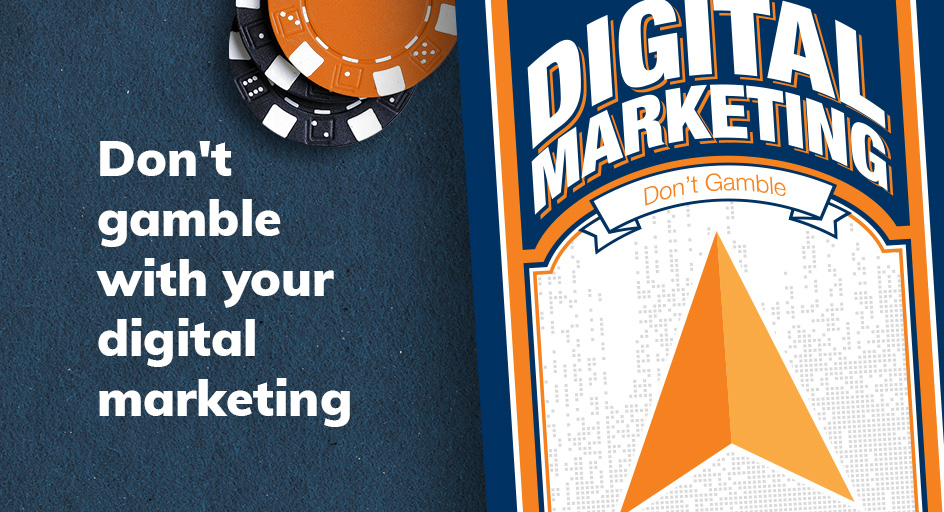If you regularly read this blog, you may sense that we are fairly particular about how we take care of our partners. Whether they work with TKG Access, our small business division, or they are a larger organization with an aggressive digital marketing strategy, we take it personally.
From strategy development to execution to measuring results, our team becomes intimately involved with our partners, so we take their wins and losses to heart. That’s why it really gets to us when we see companies gamble with their brand by trying high-risk, low-budget marketing tactics.
Don’t get me wrong. Having run a small digital agency for over 20 years, I enjoy taking risks as much as the next guy. But just like poker, risks should be calculated and strategic.
Common ways we see companies gambling with their digital marketing
- Low budget SEO: Using an offshore company for hundreds of dollars and expecting good returns
- Half-assing social media: Letting a college kid or the newbie in your business that “knows computers” manage your social media presence
- Sending “blast emails”: Using Outlook or a very low-budget email product to send the same message to thousands of email addresses a few times a year
- Investing without a strategy: Running PPC and SEO campaigns without a strategy or ROI
- Protecting your knowledge: Choosing not to share what you know with your digital audience
- Neglecting your website: Building a website with no plan for maintenance, updates and keeping information current
- Letting RFPs decide: Judging RFP responses based on price instead of strategy or value
Companies often feel the need to check the “digital marketing” or “new website” box by hiring the lowest cost provider that will show up and give them a quote or respond to their RFP. In those cases, more often than not, the wrong factors are driving the decision.
Potential consequences of gambling with your brand
Low budget SEO
SEO providers that offer extremely low prices often offer little value as well. They tend to focus on generating backlinks and traffic, and they are less concerned about providing real results. This isn’t their fault. Giving them a $200 or $300 budget isn’t going to allow them to dig into your brand.
Common unintended consequences that we end up fixing later include toxic backlinks due to poor link building strategies, keyword stuffed and over optimized website content, and blog content that is unrelated to the actual products and services a given company provides. In other words, content for the sake of content, not content for the sake of strategy. All of these issues can cause long lasting negative impacts on your brand.

Half-assing social media
Poor social media management can be a real problem. I certainly realize that not every brand needs to leverage social media for growth. However, because the web is how most people experience any new brand for the first time, it does matter. Even an industrial manufacturer needs to have a professional presence on Facebook, for instance. Potential employees and customers are likely to at least check it out to get a feel for your culture. If they land on your social media page and all they see are posts about coffee and restroom breaks, what impact might that have on your brand? Your social media presence should be managed by a true communications professional that understands social media, not a young person that just grew up with it.
Sending “blast emails”
Email marketing and marketing automation are still around today for a reason. They work. That said, if you are checking that box by sending out regular “email blasts” via Outlook, BCCing a bunch of people or using a tool like Constant Contact, you may be doing more harm than good. People expect valuable, targeted messaging from brands, not a random dump of whatever you have on sale or came across your mind. There is significant opportunity to leverage the right tool for the job, but hammering your audience with a lot of un-focused email content can damage their perception of your brand.
Investing without a strategy
Pay per click advertising has a ton of potential to help any business grow. That said, going down that road without a strategy to measure and monetize the efforts can be a bad gamble.
Google sends out credits to get you tempted. Lots of companies will take those credits and run a few ads. Sometimes that leads to a regular PPC budget that gets managed in-house. More often than not, fears about overspending prevent these companies from investing dollars based on a return on ad spend that leads to profitable revenue. The gamble for the brand here may not be significant in the short term. However, if it leads to a decision that, “PPC doesn’t work for us,” it can certainly have a huge opportunity cost. Before spending a penny on PPC, value your brand enough to set a return-on-investment expectation and only consider agencies that are willing to have that conversation with you.
Protecting your knowledge
A large part of digital marketing is the process of using the web to help your potential customers find you by demonstrating your thought leadership. It’s not uncommon that we see companies trying to use their website to, “say just enough to get them to call”. As good as that sounds, it’s not likely to work. The reality is that people buy from people and brands they trust. So, in your digital marketing efforts, don’t be afraid to educate your audience, and maybe even your competitors. The web and the markets you serve will reward you with business.
Neglecting your website
We have said it for years: Building a new website is the beginning of a process. It is not a project. The minute you launch a new website, it begins to age and atrophy. As you are setting your new website plan and budget, take the time to consider the maintenance and growth aspects of your website so you budget properly and have the expectation that this is something you need to take care of. Websites with 60-day old blog posts, past employees in photos and cars in the parking lot from the ‘90s don’t do your brand justice.
Letting RFPs decide
Web development and SEO RFPs may be two of the worst necessary evils we see on a regular basis. While I understand that large organizations and nonprofits almost have to do them, they sure don’t seem to serve the real goals very well. So, if you have no choice but put out an RFP, then so be it. But do yourself a favor and stack the deck in your favor. Build a good RFP that focuses more on the experience of the people you will be working with than it does on the price. If price is the driver, you will almost certainly choose the wrong partner and find yourself making a change in the first year. True digital marketing partnerships develop over years, not weeks or months. Change is painful and can often cost more than the original web development build or strategy.

When we work together, we win together
At the end of the day, digital marketing and web development are both more about people than they are about Facebook, email or Google. People still buy from and do business with people. The digital footprint is really just a set of tools to help us play the game. If you are going to gamble, do it with strategy.
Contact the team at The Karcher Group to work toward the collective win. We’d love to start a conversation about how digital marketing can help you achieve real business goals.



